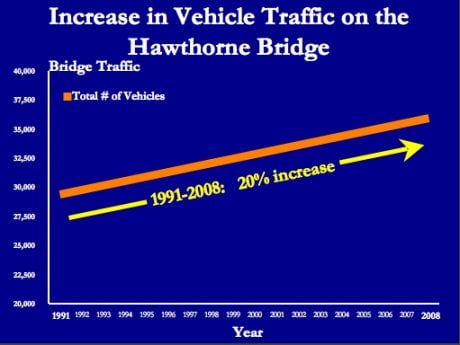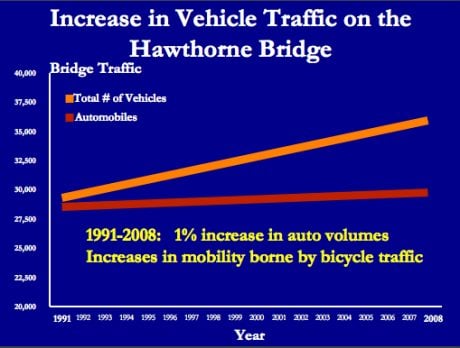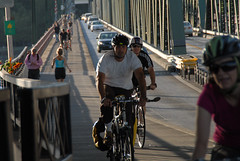Bikes do a lot of great things for our city. We often hear about the environmental benefits, the health benefits, and so on. But what about the reduced impact on our road network and congestion? What if more Portlanders drove cars into the city instead of bikes?
According to PBOT bike coordinator Roger Geller, we would have had to spend millions on wider roads and we’d be stuck in traffic a lot more often.
During a presentation given to congressional staffers on Capitol Hill at the National Bike Summit back in March, Geller made the case that it’s much nicer to drive into downtown Portland and our city has saved a ton of cash, simply because the increase in vehicle traffic on the Hawthorne Bridge is bicycles and not private automobiles.
Below are two slides from Geller’s presentation that tell this story. Each one is followed by his slide notes (emphasis mine):

The total number of vehicles on the Hawthorne Bridge has increased 20% since 1991…This increased demand for mobility is consistent with what most traffic models would predict, given increases in population and increased economic activity. This type of increased demand for mobility can spell problems for road users: more congestion, more delay and less travel reliability.
But….

In the case of the Hawthorne Bridge, the negative effects of congestion have been kept at bay. Because, while the number of vehicles increased 20% between 1991 and
19982008, that increase has been almost wholly in bicycle traffic. Had the increase been—as it might be in most places—automobiles, then the intersections at either ends of the bridge would likely have failed in their ability to effectively and efficiently move traffic.The engineering solution to this type of congestion would have been to widen the intersections, add more travel lanes to the bridge, add more green time to the movements onto the bridge. In reality, because there are scant funds for such improvements, nothing would have been done and the costs would have been those of increased congestion.
However, because the increased demand for mobility has been borne almost exclusively by the bicycle, automotive traffic flows in this area the same today as it did in 1991. It is for this reason, in part, that Portland’s award winning traffic engineer, Rob Burchfield, states that: “Bicycling infrastructure is relatively easy to implement and low cost compared to other modes. It is by far the most cost-effective way to provide for personal mobility in an urban transportation system.”
Add this to your quiver of weapons to battle non-believers.


